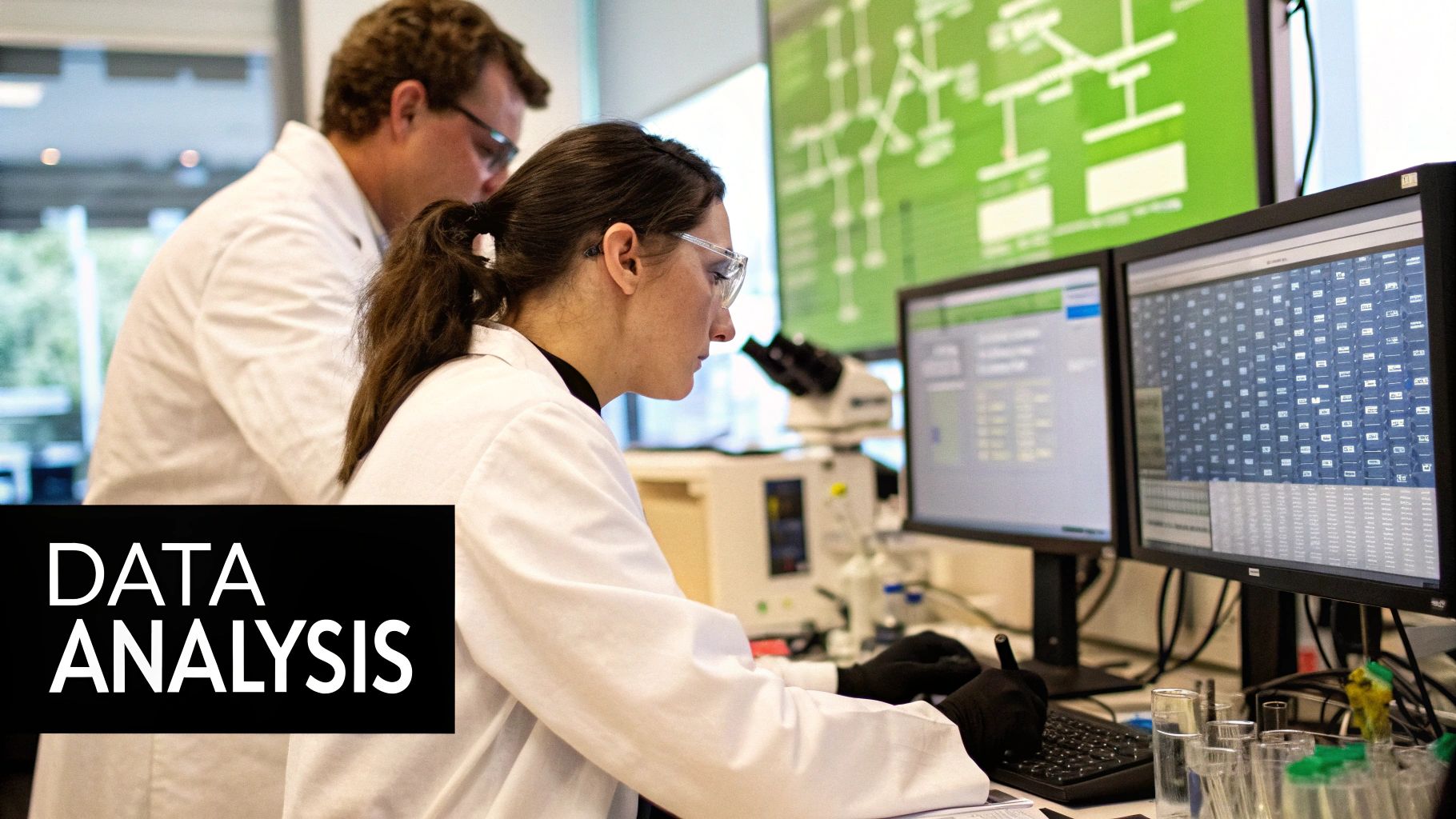Artificial Intelligence Detector: Expert Guide to Mastering Content Authentication
Understanding the Reality of AI Detection

When people hear “AI detector,” they often imagine flawless software that can instantly spot computer-generated text. The truth is more complex. These detection tools rely on sophisticated algorithms and statistical analysis to identify potential AI-written content. Understanding how they actually work is key to using them effectively and interpreting their results accurately.
How AI Detectors Work: A Look Under the Hood
AI detection tools use several methods to analyze text for signs of machine generation. Natural Language Processing (NLP) examines writing patterns, word choices, and stylistic elements that might indicate AI authorship. For instance, AI writing often shows repetitive phrasing or lacks the natural variation found in human writing. The tools also use pattern recognition to spot statistical irregularities, such as unusually consistent sentence lengths or missing semantic quirks that typically appear in human writing. This approach is similar to how email spam filters work by identifying suspicious patterns in messages.
Strengths and Limitations of Current AI Detection Technologies
While AI detectors serve an important purpose, they come with clear limitations. A key challenge is keeping pace with rapidly improving AI writing models that become better at mimicking human writing styles. This creates an ongoing competition between detection tools and AI writing technology. Another significant issue is false positives – when these tools incorrectly flag human-written text as AI-generated. This can be particularly problematic in academic settings where wrongly identifying AI use could have serious consequences. These limitations show why AI detectors should be used as one tool among many rather than the final word on content authenticity. You might be interested in: How to master content authentication with SmartStudi.
Real-World Applications and Ethical Considerations
AI detection tools have found practical uses across different fields despite their constraints. Schools use them to help maintain academic honesty, while news organizations employ them to verify source authenticity. However, using these tools brings up important ethical questions. It’s essential to ensure detection algorithms work fairly and avoid bias, especially when used for important decisions like grading student work. Being open about how these tools work and what they can and cannot do helps build trust and encourages responsible use. This balanced approach becomes more important as AI detection technology grows more common and its influence expands.
Breaking Down Detection Accuracy Claims

When it comes to AI detection tools, accuracy claims vary widely – from modest success rates to near-perfect results. But what’s really behind these numbers? Understanding how to evaluate these claims requires looking at several key factors that influence detection effectiveness.
The Elusive “Accuracy” Figure: Understanding the Variables
Comparing accuracy rates is challenging because there’s no standard testing approach across tools. For instance, OpenAI’s AI Classifier achieved only 26% accuracy before being discontinued. While this may seem low, it reflects the complexity of detecting constantly evolving AI text. In contrast, Turnitin reports 98% accuracy for its detector. This stark difference shows why we need to examine what data and testing methods were used to determine these rates.
The type of content being analyzed also significantly impacts detection success. Technical writing with its structured format and specific vocabulary may be easier to identify as AI-generated. However, creative writing with its nuanced expression poses a greater challenge for detectors. This means a tool that works well for one type of text might struggle with another, making accuracy claims more complex than they first appear.
Case Studies and Real-World Performance: Beyond the Numbers
To properly assess AI detectors, we need to look at how they perform in actual use. For example, Turnitin’s analysis of over 200 million papers found that 11% contained at least 20% AI-generated content. This real-world data provides valuable context about how these tools work in practice. Interestingly, only 3% of papers showed more than 80% AI content, suggesting that while students have access to AI writing tools, they’re not relying on them exclusively for their work.
Factors Influencing Success: What Makes a Detector Tick?
The effectiveness of AI detectors depends heavily on their underlying technology and training data. These tools work similarly to email spam filters, searching for patterns that indicate machine authorship. However, as AI writing tools become more advanced, detectors must constantly evolve to keep pace, creating an ongoing challenge between generation and detection technology.
The rise of hybrid content – text that combines human and AI writing – adds another layer of complexity. Detecting these mixed sources requires more sophisticated analysis to determine the origin of different text sections. This highlights why AI detectors should be one part of a broader content verification approach rather than the only solution. Success in AI detection requires understanding both the capabilities and limitations of different tools to develop an effective strategy.
Navigating Educational Detection Practices
As AI writing tools become more common in education, schools and universities are working to find effective ways to maintain academic integrity while adapting to new technology. Rather than simply policing student work, institutions are developing thoughtful approaches to promote ethical technology use and preserve trust in academic communities.
Finding Balance Between Technology and Academic Standards
Educational institutions face a complex task: making good use of helpful technology while ensuring students maintain academic honesty. AI writing tools can benefit the learning process through brainstorming and writing practice, but their misuse for plagiarism threatens academic standards. Leading schools are responding by creating clear guidelines for appropriate AI use, incorporating AI literacy into coursework, and thoughtfully integrating detection tools into existing academic integrity systems. Many institutions now facilitate open discussions about using technology ethically in education.
Making Detection Work in Practice
Success with AI detection requires more than just implementing new software. Schools must consider student perspectives, address faculty needs, and develop clear, fair policies. Building trust through transparency is essential – institutions find the best results when they openly explain how detection tools work, acknowledge their limitations, and clarify how results will be used. This openness helps reduce student anxiety about false positives while keeping the focus on promoting good academic practices. Schools also provide writing resources like the SmartStudi grammar checker to help students improve their skills naturally.
Understanding Student and Faculty Perspectives
The introduction of AI detection has sparked important discussions among students and teachers. Students raise valid concerns about potential false accusations, while also recognizing the need to maintain academic standards. Faculty members have varied views – some welcome detection tools as helpful for upholding integrity, while others worry about impacts on student learning and creativity. Creating forums for open dialogue about these issues helps develop better policies and fosters an environment where technology supports rather than hinders education.
Learning from Real Experience
Data from actual AI detection implementations provides valuable insights. For example, Turnitin’s analysis of over 200 million papers shows that while AI use exists, it’s not as widespread as some fear, with only a small percentage of work being primarily AI-generated. However, the presence of some AI-generated content in papers highlights the ongoing need for monitoring and education. These real-world findings help schools refine their approaches, focusing on teaching responsible AI use rather than just enforcement. This evidence-based understanding shapes more effective ways to maintain academic integrity as AI technology continues to evolve.
Choosing the Right Artificial Intelligence Detector
AI detection tools play an essential role in content verification, but selecting the most suitable one requires careful evaluation. Since different tools serve different purposes, understanding your specific needs is crucial for making an informed choice. Let’s explore how to assess and select an AI detection tool that aligns with your goals.
Key Features to Consider
Each AI detection tool has its unique strengths, similar to how different tools serve specific purposes in a toolbox. Academic institutions might need tools that excel at identifying paraphrased AI content, while businesses may prioritize tools that verify content authenticity.
Here are the essential features to evaluate:
- Accuracy: Look beyond the headline accuracy numbers. Focus on how well the tool performs with your specific type of content.
- Integration Capabilities: The tool should fit seamlessly into your existing workflow. Consider whether it offers APIs or plugins compatible with your current systems. For educators, integration with learning management systems is particularly important.
- User Experience: An intuitive interface makes a significant difference in daily use. The tool should be easy to navigate regardless of technical background.
- Cost-Effectiveness: Compare pricing models against your budget and needs. Free versions with basic features can help you test the waters before committing to a paid plan.
Comparing Leading AI Detection Platforms
The following comparison table outlines key differences between major AI detection services:
FeatureGPTZeroTurnitinOriginality.aiWinston.aiCopyleaksAccuracyHigh for academic writingModerate across content typesHigh for codeModerate for educational contentHigh for various content typesIntegrationLMS IntegrationExtensive API AccessLimited IntegrationLMS IntegrationAPI and LMS IntegrationUser ExperienceIntuitiveComplexSimpleUser-friendlyModerate complexityCostPremiumPremiumFreemiumSubscription-basedSubscription-based
As shown, each service offers unique benefits. GPTZero is well-suited for academic use, Turnitin provides extensive API integration options, Originality.ai excels in code detection, Winston.ai offers a user-friendly interface for educational content, and Copyleaks combines various integration capabilities.
Deployment Strategies and Pitfalls
Selecting the right tool is just the first step. Successful implementation requires thoughtful planning and awareness of common challenges. Start by establishing clear guidelines for tool usage and response protocols. For instance, if a student’s paper triggers a false positive, having clear procedures in place helps avoid unfair consequences.
User training is equally important – staff need to understand both the tool’s capabilities and its limitations. Regular monitoring helps track performance and user feedback, ensuring the tool continues to meet your needs as AI writing technology evolves.
Building an Effective Detection Strategy
Creating an effective AI detection strategy involves careful planning across multiple areas. A successful approach needs clear policies, proper training, and thoughtful consideration of ethics. Let’s explore how to build a strategy that works well while being responsible and transparent.
Establishing Clear Policies and Procedures
Strong policies form the foundation of any AI detection program. Your policy should clearly explain why you’re using the detector, what content it will analyze, and how you’ll handle the results. For instance, in education, a policy might state that all essay submissions will be scanned and that teachers will review any flagged content before taking action. Including specifics about data privacy and protection helps build trust with users. Clear expectations and fair processes encourage everyone to use the system properly.
Training Users for Effective Implementation
Success with AI detection tools depends heavily on proper user training. Staff need to learn both the technical aspects – like reading results and using the interface – and understand the tools’ limitations. For example, users should know that a high AI probability score doesn’t automatically mean cheating occurred – the student may have used AI tools appropriately for brainstorming or outlining. This balanced understanding leads to better decisions and prevents over-reliance on the tool’s output. Learn more in our guide on How to master your results page.
Addressing Ethical Considerations and Maintaining Transparency
Using AI detection tools raises important questions about privacy and fairness. Being open about how the tool works, what it can and cannot do, and how results will be used helps build trust. For example, explaining that the goal is supporting academic integrity rather than punishing students can reduce anxiety. Regular reviews ensure the tool isn’t unfairly flagging certain groups or writing styles. This ongoing evaluation keeps the implementation ethical and fair for all users.
Measuring Success Beyond Accuracy
While detection accuracy matters, it shouldn’t be the only measure of success. Consider factors like user satisfaction, workflow efficiency, and progress toward your goals. In academic settings, success might mean both accurately identifying AI-written text and seeing fewer instances of it over time. Looking at multiple factors provides better insights into how well the tool works in practice. This broader view helps identify what’s working well and what needs improvement, leading to better outcomes for everyone using the system.
Preparing for the Future of Detection

As AI detection tools continue to advance, understanding where this technology is headed becomes essential for anyone working with content verification. The methods used to identify AI-generated text are becoming more refined and nuanced, requiring users to stay informed about the latest developments in this field.
Evolving to Combat Sophisticated AI Writing
AI writing tools are growing more advanced, creating new challenges for detection systems. Mixed content that combines human and AI writing requires more precise analysis methods. The rise of outputs created by multiple AI models working together adds another layer of complexity. These changes push detection tools to develop more accurate and thorough verification approaches.
Breakthrough Developments in Authentication
New methods for verifying content authenticity show great potential. Rather than just looking for patterns, these techniques analyze deeper aspects of how content is created. For example, some systems now use digital signatures embedded in text to confirm its source. This makes it possible to definitively determine whether a human or machine created the content. Other approaches focus on identifying subtle language patterns that AI systems struggle to replicate consistently.
The Ongoing Arms Race: Staying Ahead
AI writing and detection technologies are locked in a constant back-and-forth. As AI writing gets better at mimicking human text, detection tools must improve to spot these more convincing imitations. This competition drives progress in both areas. To use detection tools effectively, organizations need to monitor new developments and understand how capabilities are changing.
Practical Advice for the Future
Success in content verification requires several key steps. Start by learning how AI writing and detection technologies actually work – this helps you choose the right tools for your needs. Make time to regularly learn about new developments, since AI capabilities change quickly. Consider using multiple verification methods together, since relying on just one approach can be risky as AI writing evolves. A combined strategy provides better protection against increasingly sophisticated AI-generated content.
Ready to experience the future of content authentication? SmartStudi offers cutting-edge AI detection and paraphrasing tools designed to meet the evolving needs of students and educators. Visit SmartStudi today to explore our suite of AI-powered solutions and take control of your content integrity.